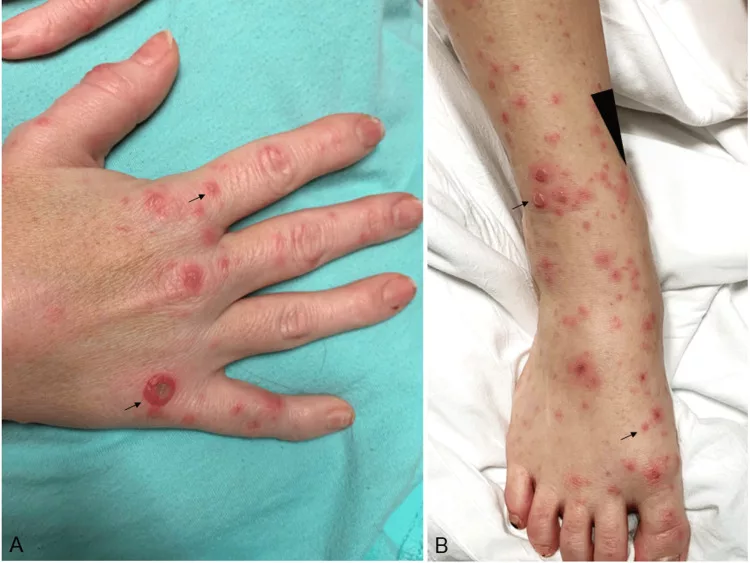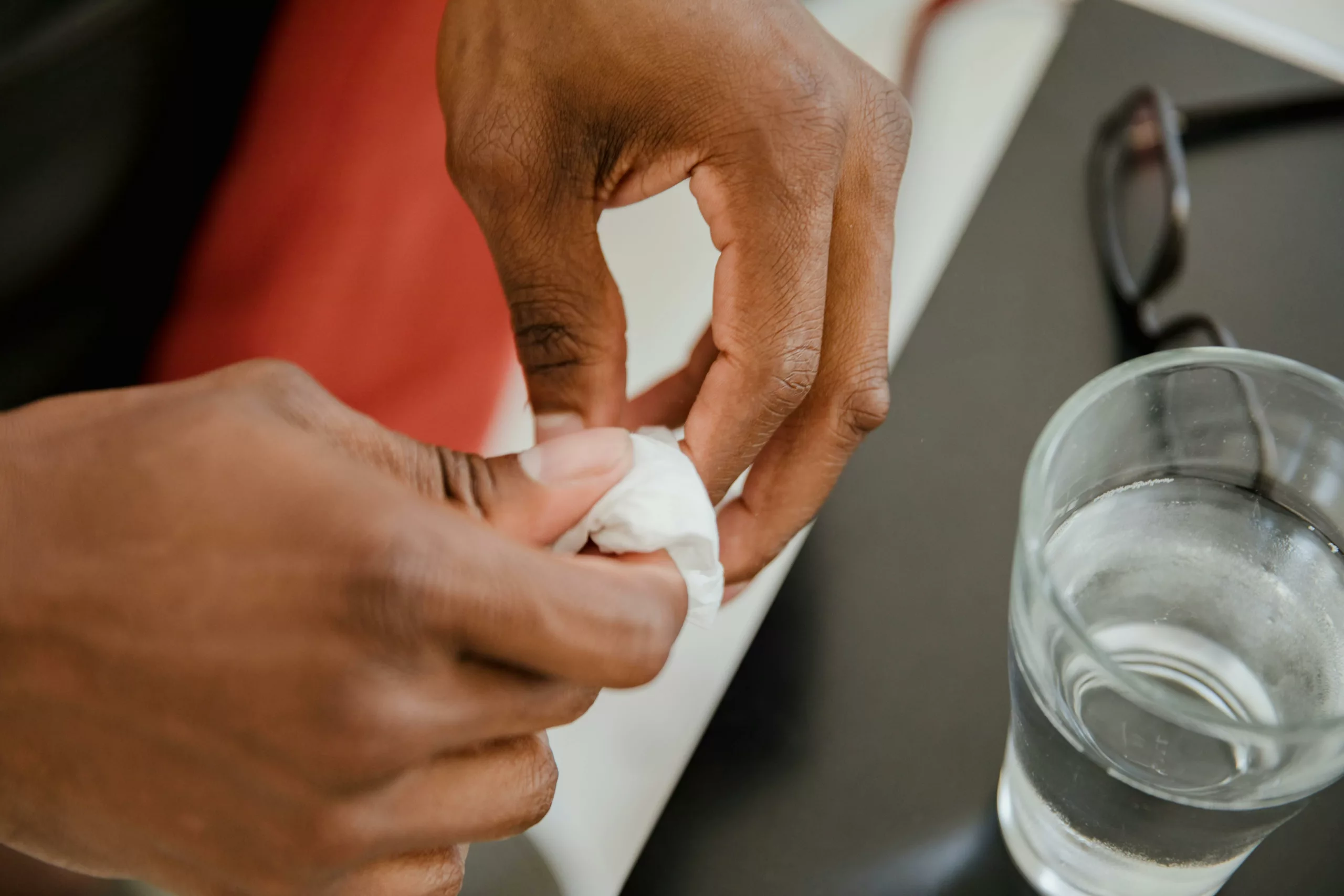Rat Bite Fever (RBF), also known as Epidemic Arthritic Erythema, is a rare bacterial infection transmitted to humans by contact with rats (via bites, scratches, body fluid/secretion exchange, etc.). Although the literature is scarce, reports suggest that national Emergency Department visits for the condition from 2001 to 2015 were 0.33/1,000,000 persons, with most patients aged 0 to 19.1Kache, P. A., Person, M. K., Seeman, S. M., McQuiston, J. R., McCollum, J., & Traxler, R. M. (2020, June). Rat-bite fever in the United States: An analysis using multiple national data sources, 2001–2015. In Open Forum Infectious Diseases (Vol. 7, No. 6, p. ofaa197). US: Oxford University Press. There is generally a 10% chance of RBF after a rat bite. Different species of bacteria can cause the disease.2Murtaza, G., Kausar, R., Zaidi, B., Habib, A., Arshad, M. Z., Adil, M., … & Randhawa, A. H. (2023). Rat bite fever human disease. Zoonosis, Unique Scientific Publishers, Faisalabad, Pakistan, 4, 573-586.
However, the symptoms caused by the different bacteria types mainly include headache, fever, lymph node swelling, skin rash, etc. Patients may also experience joint and muscle aches. Though mild, untreated rate bite fever can lead to serious consequences and even death. If left untreated it has a mortality rate of around 10%. Doctors treat the condition with antibiotics like tetracycline.
Types Of Rat Bite Fever
Based on the types of bacteria causing the disease, RBF is divided into two types:
Spirillary Fever:
This type is seen mostly in Asian countries with most cases having been reported in Japan where it is called Sodoku (which means rat poison). It is caused by the bacteria Spirillum minus, which is why it’s called spirillary fever.
Haverhill Fever:
It is caused by the bacteria Streptobacillus moniliformis which is native to the United States (especially North America). It is also called streptobacillary rat-bite fever.
Rat Bite Fever Symptoms
The S. moniliformis bacteria has an incubation period of 3-10 days. Thus, most patients experience symptoms 7-21 days after exposure to the bacteria. The most prevalent symptoms of RBF include:

Fever & Chills
Several patients complain of repeated episodes of fever. Other symptoms like skin rash, body aches, and chills almost always accompany the relapsing fever. Studies show that the classic representation of RBF (especially with S. moniliformis infection) includes the following symptoms3Elliott, S. P. (2007). Rat bite fever and Streptobacillus moniliformis. Clinical microbiology reviews, 20(1), 13-22.:
- Fever
- Rigors
- Polyarthralgias (generalized body pains)
Skin Symptoms
You can see a red rash developing on the site of the rat scratch or bite. Some report red skin rash while others complain of having purple lesions. According to a clinical study, a female patient developed purple lesions and hemorrhagic pustules on the hands and feet. The blood-filled skin lesions were painful.4Kämmerer, T., Lesmeister, T., Wollenberg, A., French, L. E., Strobel, E., & Reinholz, M. (2021). Rat bite fever, a diagnostic challenge: case report and review of 29 cases. JDDG: Journal der Deutschen Dermatologischen Gesellschaft, 19(9), 1283-1287. You may also encounter ulcerations on the bite site. An erythematous maculopapular rash may spread across the body as a consequence of rat-bite fever.
Headaches
Headache is an evident feature of this rare bacterial infection. In most cases, fever and nausea accompany headaches. The combination of these symptoms may mimic more serious conditions like vasculitis.5Błaż, A., Zalewski, J., Masiak, A., Kujawa, M. J., Gosz, M., & Buda, N. (2023). Rat bite fever mimicking ANCA-associated vasculitis. Rheumatology International, 43(10), 1957-1964.
Nausea & Vomiting
Haverhill fever is notorious for causing severe nausea and vomiting in patients. Feelings of nausea generally appear as initial symptoms and most individuals also have concurrent sore throat.6Pal, M., & Gutama, K. P. (2023). Rat Bite Fever: An Infectious Under-Reported Bacterial Zoonotic Disease. American Journal of Public Health, 11(3), 84-87.
Sore Throat
A sore throat with recurrent fever and swollen joints following interaction with rats must raise concerns. Many patients notice soreness of the throat in combination with body aches, and swollen lymph nodes. Sometimes, individuals may also experience earaches, and general malaise too.7Coessens, M., & De Laere, E. (2022). Rat bite fever: a case report review. Acta Clinica Belgica, 77(5), 883-888.
Lymph Node Swelling
The zoonotic bacterial infection can cause your lymph nodes to swell up. It is mostly the lymph nodes present close to the bite site that swell up.8Gaastra, W., Boot, R., Ho, H. T., & Lipman, L. J. (2009). Rat bite fever. Veterinary microbiology, 133(3), 211-228.
Arthralgias/Myalgias
Generalized body aches can interfere with your daily activities. Muscle pains (myalgias) and joint pains (arthralgia) are strongly associated with RBF. There have been cases where patients reported to the ER with fever, myalgias, and polyarthralgia.9Pongsuttiyakorn, S., Kamolvit, W., Limsrivanichakorn, S., Phothisirisakulwong, A., & Wangchinda, W. (2021). Rat bite fever due to Streptobacillus botrytis complicated by meningitis and spondylodiscitis: a case report. BMC Infectious Diseases, 21, 1-5. Thus, it is a significant feature of the rat bite disease.
In rat bite fever, the pain seems to shift from one joint to another, a condition called migratory polyarthralgia. It is a unique feature of the zoonotic illness. However, numerous patients infected with S. moniliformis have reported recurring fevers and migratory polyarthritis.
Causes Of Rat Bite Fever
As already mentioned, rat bite fever causative agents are S. moniliformis and S. minus bacteria. Humans generally acquire bacterial infection after being in direct/close contact with infected rats which serve as hosts for the bacterial pathogen. The bacteria reside in the mouths and respiratory tracts of rats from where they get transmitted to humans.
In addition to rats, you can acquire rat bite fever by contact with the following infected animals:
- Squirrels
- Guinea pigs
- Gerbils
- Mice
Rat Bite Fever Transmission:
The main mode of transmission from rats to humans is via skin contact i.e.:
- Bites
- Scratches
Another mode of transmission is the transfer of infected animal’s secretions including urine, poop, or saliva via an open wound or body openings like eyes, nose, or mouth. Pediatric patients usually acquire the infection by touching surfaces contaminated with rat secretions.10Edholm, A., Heyer, M., & Nemetski, S. M. (2021). Rat-bite Fever: A Rare Diagnosis for a Common Pediatric Presentation: Case Report. Clinical Practice and Cases in Emergency Medicine, 5(4), 407.
You can also fall prey to the zoonotic illness by ingesting foods/drinks contaminated by the bacteria. Consuming foods mixed with the body fluids of infected rats can make you sick.
However, it is noteworthy that S. moniliformis can cause disease if you drink unpasteurized milk containing the bacteria but S. minus does not cause disease by ingestion of the pathogen. This means you can acquire Haverhill fever by food ingestion but not spirillary fever.
Risk Groups
The following people are at a greater risk of RBF:
- Residents of Japan and North America
- People who keep mice, rats, and guinea pigs as pets
- Professionals (pet store owners, vets, etc.) involved in handling rats and rodents
- Individuals with weak immunity (HIV patients, etc.)
Is It Contagious?
No, there are no reported cases of man-to-man transmission of the RBF.
Rat Bite Fever Diagnosis
Your healthcare provider will start by taking a complete history of the symptoms and then perform a physical examination. Physicians usually check for features like rash, lymph node swelling, and joint/muscle pains.
If suspected your doctor may order several tests to detect the presence of the causative agents of rat bite fever. In general, professionals draw blood, joint fluid, and lymph (from lymph nodes) from your body and send it to the lab to detect the presence of causative bacteria. In the lab, pathologists observe the fluid samples under a microscope.
Other diagnostic tests (mainly for S. moniliformis) include:
- PCR assays
- Serological assays
Rat Bite Fever Treatment
The bacterial illness is completely curable but requires early diagnosis to prevent complications. Treatment involves a course of antibiotics. The most commonly prescribed antibiotics that are efficient for rat bite fever include:
- Penicillin
- Ampicillin
- Ceftriaxone
- Tetracycline
Modern studies show that oral penicillin effectively treats RBF. Therefore, it is the first drug of choice. Doxycycline and third-generation cephalosporins can serve as effective alternatives to penicillin (in cases allergic or resistant to penicillin).11Kaur, A., Mohammadi, M. R., Kumar, R., & Sharma, A. (2024). Streptobacillus moniliformis and Spirillum minus infection: Rat-bite fever. Nano Micro Biosystems, 3(1), 1-6.
Note: You need to complete the course of antibiotic therapy and not leave it in between. Not following the course can make the bacteria resistant to treatment, making it more difficult to treat when it recurs.
Rat Bite Fever Complications
While RBF can be managed easily with timely antibiotic therapy, untreated infection can lead to serious complications. Reports suggest that complications arise in approximately 1/3rd of cases.12Croker, B. A., Prudence, A., Wilson, P. A., Givney, R., & O’Kane, G. (2021). Rat-bite fever due to Streptobacillus moniliformis: a case series from New South Wales, Australia, and literature review. Infectious Diseases in Clinical Practice, 29(4), e208-e214. Most common grave consequences of the bacterial syndrome include:
- Endocarditis (inflammation of the inner lining of the heart chambers and valves), pericarditis and endocarditis
- Septic arthritis (joint inflammation due to infection)
There have been reports of life-threatening S. moniliformis-induced mitral valve endocarditis and septic arthritis in patients.13Torres-Miranda, D., Moshgriz, M., & Siegel, M. (2018). Streptobacillus moniliformis mitral valve endocarditis and septic arthritis: the challenges of diagnosing rat-bite fever endocarditis. Infectious disease reports, 10(2), 7731.
Other rare yet serious complications that may arise due to RBF include:
- Meningitis
- Hepatitis
- Nephritis
- Polyarteritis nodosa
Improper/incomplete treatment can lead to severe illness (mainly cardiac complications) and even death. The mortality rate of untreated RBF is 10-13%.14Edholm, A., Heyer, M., & Nemetski, S. M. (2021). Rat-bite Fever: A Rare Diagnosis for a Common Pediatric Presentation: Case Report. Clinical Practice and Cases in Emergency Medicine, 5(4), 407.
Management After A Rat Bite
To avoid development of infection, you need to adopt the following steps immediately after the bite:

- Control the bleeding by pressing on the wound. You can use a gauze or a paper towel.
- Rinse/clean the wound with warm water and antibacterial soap. You may also clean the wound with hydrogen peroxide or apply antibiotic ointment (Neosporin, etc.) before covering the wound.
- Cover the wound with a clean gauze dressing.
- Try to trap the rat so that it can be examined by a health professional later.
Prevention From Rat Bite Fever
You can prevent RBF by adopting these steps:
- Try to minimize contact with rodents, rats, and mice.
- If contact is unavoidable use protective gear (rubber gloves, mask and goggles, etc.)
- Use disinfectants and sanitizers after handling pets.
- Keep rats (and their secretions) away from food items.
Final Word
Rat bite fever is a rare bacterial infection caused by two different species of bacteria i.e., Spirillum minus (causes Sodoku) in Asia and Streptobacillus moniliformis (causes Haverhill fever) in America. The bacteria are transmitted to humans via rat scratches, bites, or fluid exchange. You can also acquire Haverhill fever by ingesting food items contaminated with rat fluids (pee, poop, and saliva).
The disease presents with relapsing fever, headaches, maculopapular rash (red/purple), painful pustules, lymph node swelling, and migrating polyarthritis. Doctors treat it effectively with antibiotics like penicillin. Other effective alternatives to penicillin are cephalosporins and doxycycline. Timely diagnosis and treatment are crucial because RBF may cause serious complications like septic arthritis and life-threatening endocarditis.
Refrences
- 1Kache, P. A., Person, M. K., Seeman, S. M., McQuiston, J. R., McCollum, J., & Traxler, R. M. (2020, June). Rat-bite fever in the United States: An analysis using multiple national data sources, 2001–2015. In Open Forum Infectious Diseases (Vol. 7, No. 6, p. ofaa197). US: Oxford University Press.
- 2Murtaza, G., Kausar, R., Zaidi, B., Habib, A., Arshad, M. Z., Adil, M., … & Randhawa, A. H. (2023). Rat bite fever human disease. Zoonosis, Unique Scientific Publishers, Faisalabad, Pakistan, 4, 573-586.
- 3Elliott, S. P. (2007). Rat bite fever and Streptobacillus moniliformis. Clinical microbiology reviews, 20(1), 13-22.
- 4Kämmerer, T., Lesmeister, T., Wollenberg, A., French, L. E., Strobel, E., & Reinholz, M. (2021). Rat bite fever, a diagnostic challenge: case report and review of 29 cases. JDDG: Journal der Deutschen Dermatologischen Gesellschaft, 19(9), 1283-1287.
- 5Błaż, A., Zalewski, J., Masiak, A., Kujawa, M. J., Gosz, M., & Buda, N. (2023). Rat bite fever mimicking ANCA-associated vasculitis. Rheumatology International, 43(10), 1957-1964.
- 6Pal, M., & Gutama, K. P. (2023). Rat Bite Fever: An Infectious Under-Reported Bacterial Zoonotic Disease. American Journal of Public Health, 11(3), 84-87.
- 7Coessens, M., & De Laere, E. (2022). Rat bite fever: a case report review. Acta Clinica Belgica, 77(5), 883-888.
- 8Gaastra, W., Boot, R., Ho, H. T., & Lipman, L. J. (2009). Rat bite fever. Veterinary microbiology, 133(3), 211-228.
- 9Pongsuttiyakorn, S., Kamolvit, W., Limsrivanichakorn, S., Phothisirisakulwong, A., & Wangchinda, W. (2021). Rat bite fever due to Streptobacillus botrytis complicated by meningitis and spondylodiscitis: a case report. BMC Infectious Diseases, 21, 1-5.
- 10Edholm, A., Heyer, M., & Nemetski, S. M. (2021). Rat-bite Fever: A Rare Diagnosis for a Common Pediatric Presentation: Case Report. Clinical Practice and Cases in Emergency Medicine, 5(4), 407.
- 11Kaur, A., Mohammadi, M. R., Kumar, R., & Sharma, A. (2024). Streptobacillus moniliformis and Spirillum minus infection: Rat-bite fever. Nano Micro Biosystems, 3(1), 1-6.
- 12Croker, B. A., Prudence, A., Wilson, P. A., Givney, R., & O’Kane, G. (2021). Rat-bite fever due to Streptobacillus moniliformis: a case series from New South Wales, Australia, and literature review. Infectious Diseases in Clinical Practice, 29(4), e208-e214.
- 13Torres-Miranda, D., Moshgriz, M., & Siegel, M. (2018). Streptobacillus moniliformis mitral valve endocarditis and septic arthritis: the challenges of diagnosing rat-bite fever endocarditis. Infectious disease reports, 10(2), 7731.
- 14Edholm, A., Heyer, M., & Nemetski, S. M. (2021). Rat-bite Fever: A Rare Diagnosis for a Common Pediatric Presentation: Case Report. Clinical Practice and Cases in Emergency Medicine, 5(4), 407.

